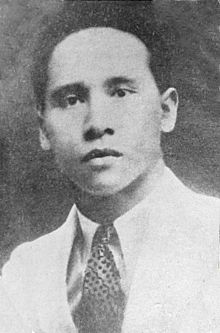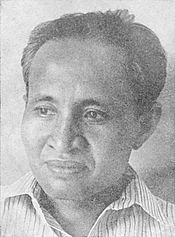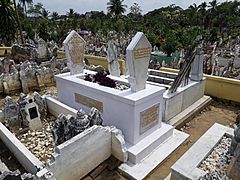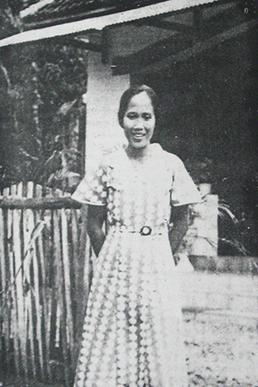Amir Hamzah facts for kids
Quick facts for kids
Tengku
Amir Hamzah
Pangeran Indra Poetera
|
|
|---|---|

Amir Hamzah, c. 1928–1937
|
|
| Born | Tengku Amir Hamzah 28 February 1911 Tanjung Pura, Langkat, Dutch East Indies |
| Died | 20 March 1946 (aged 35) |
| Resting place | Azizi Mosque, Tanjung Pura, Langkat, Indonesia |
| Occupation | Poet |
| Language | Indonesian/Malay |
| Nationality | Indonesian |
| Genre | Poetry |
| Subject | Love, religion |
| Notable works |
|
| Spouse |
Tengku Puteri Kamiliah
(m. 1937) |
| Children | 1 |
Tengku Amir Hamzah (born February 1911 – died 20 March 1946) was a famous Indonesian poet. He is also known as a National Hero of Indonesia. Amir Hamzah was born into a noble Malay family in the Sultanate of Langkat, North Sumatra. He studied in both Sumatra and Java.
Around 1930, while in high school in Surakarta, Amir joined the movement for Indonesian independence. He also fell in love with a Javanese schoolmate named Ilik Sundari. They stayed close even when Amir went to law school in Batavia (now Jakarta). But in 1937, Amir had to return to Sumatra. He was called back to marry the sultan's daughter and take on duties at the royal court.
Amir was not happy with his marriage, but he did his court duties. After Indonesia declared its independence in 1945, he became the government's representative in Langkat. The next year, he was killed during a social uprising and buried in a mass grave.
Amir started writing poems as a teenager. His earliest works are thought to be from when he first went to Java. He was influenced by his Malay culture, Islam, and Eastern literature. Amir wrote 50 poems, 18 lyrical prose pieces, and many other works, including translations. In 1932, he helped start the literary magazine Poedjangga Baroe. After returning to Sumatra, he stopped writing. Most of his poems were published in two collections: Nyanyi Sunyi (1937) and Buah Rindu (1941).
Amir's poems often explore themes of love and religion. They show his deep inner struggles. He used both Malay and Javanese words in his writing. His style was shaped by the need for rhythm and special meanings. His early poems are about longing and ideal love. His later works have deeper religious meanings. Nyanyi Sunyi is seen as his most developed collection. Amir is called the "King of the Poedjangga Baroe-era Poets." He is also considered the only Indonesian poet of international class before the Indonesian National Revolution.
Contents
Early Life and Education
Amir was born as Tengkoe Amir Hamzah Pangeran Indra Poetera in Tanjung Pura, Langkat, North Sumatra. He was the youngest son of Vice Sultan Tengku Muhammad Adil. His family was related to the Sultan of Langkat. The Indonesian government officially recognizes his birth date as 28 February 1911.
Amir learned about Islamic principles from a young age. He studied at the Azizi Mosque in Tanjung Pura. He remained a devoted Muslim throughout his life. He started formal school around 1916 or 1918. At his Dutch-language elementary school, he began writing and got good grades. His classmates called him "older brother" because he was much taller than them.
Around 1924 or 1925, Amir finished school in Langkat. He then moved to Medan to study at the Meer Uitgebreid Lager Onderwijs (MULO), which was a middle school. After two years, he became engaged to his cousin, Aja Bun. His parents allowed him to finish his studies in Java. So, Amir moved to the capital city, Batavia (now Jakarta), to continue his education.
Time in Java
Amir traveled by boat to Java. In Batavia, he enrolled in a Christian MULO for his last year of junior high. He also joined a social group called Jong Sumatera. During this time, Amir wrote his first poems. Some say he wrote them after his engagement to Aja Bun ended. Others believe he wrote about missing his parents.
After a short visit to Sumatra, Amir went to a high school in Surakarta, Central Java. There, he studied Eastern literature and languages. These included Javanese, Sanskrit, and Arabic. Amir preferred quiet places. He lived in a private home instead of the busy dorms. He met future writers like Armijn Pane and Achdiat Karta Mihardja. They found him to be a friendly and hardworking student. But he was also a romantic, often lost in thought.
In Surakarta, Amir joined the nationalist movement. He met with other Sumatrans to talk about Dutch colonial rule. While most educated young people spoke Dutch, Amir insisted on speaking Malay. In 1930, he became the head of the Indonesia Muda (Young Indonesians) group in Surakarta. He gave a speech at the 1930 Youth Congress. He also edited the group's magazine, Garuda Merapi.
At school, he met Ilik Sundari, a Javanese girl. They fell in love. Sundari was one of the few female students. Her home was near where Amir lived. They grew closer, with Amir teaching Sundari Arabic and Sundari teaching him Javanese. They met daily and talked about many things.
Amir's mother died in 1931, and his father died the next year. This meant he could no longer pay for his education. He wanted to study law in Batavia. His brother, Jakfar, arranged for the Sultan to pay for his studies. In 1932, Amir returned to Batavia and started law school. He also worked part-time as a teacher. He and Sundari continued their relationship through letters. She later moved closer to Batavia, allowing them to meet secretly. Her parents had forbidden them from meeting.
In 1932, Amir's first two poems were published in the magazine Timboel. He published eight other works that year. These included a syair (a type of poem) and lyrical prose. Around September 1932, Armijn Pane and Sutan Takdir Alisjahbana asked Amir to help start a new literary magazine. Amir agreed. He was in charge of writing letters to ask writers for their work. After months of preparation, the first issue of Poedjangga Baroe was published in July 1933. Amir published almost all his later writings in this new magazine.
In mid-1933, Amir was called back to Langkat. The Sultan told him he had to be a good student and leave the independence movement to continue his studies. Despite the Sultan's disapproval, Amir became more involved in the nationalist movement. This made the Dutch government watch him more closely. He kept publishing in Poedjangga Baroe. This included articles on Eastern literature and a translation of the Bhagavad Gita. However, his law studies were delayed. By 1937, he still had not graduated.
Return to Langkat and Later Life
The Dutch government was worried about Amir's nationalist ideas. They convinced the Sultan to send him back to Langkat. Amir could not refuse this order. In 1937, Amir returned to Sumatra. When he arrived in Langkat, he was told he would marry the Sultan's eldest daughter, Tengku Puteri Kamiliah. He barely knew her.
Before the wedding, Amir went back to Batavia for his final exam. He also had one last meeting with Sundari. Weeks later, he returned to Langkat. He and Kamiliah were married in a grand ceremony. His cousin said Amir seemed distant during the seven-day event. He was likely thinking of Sundari.
Now a prince (pangeran), Amir received the title Tengku Pangeran Indra Putera. He lived with Kamiliah in their own home. She was a devoted and loving wife. In 1939, they had their only child, a daughter named Tengku Tahura. Amir reportedly told Kamiliah that he could never love her as he loved Sundari. He felt he had to marry her. Kamiliah reportedly accepted this. Amir kept an album of Sundari's photos at home. He often spent time alone, lost in thought.
As a prince of Langkat, Amir became a court official. He handled administrative and legal matters. He sometimes judged criminal cases. He once represented the sultanate at a funeral in Java. This was Amir's last trip to the island.
Even though Amir had little contact with his friends in Java, his poems continued to be published in Poedjangga Baroe. Most of these poems had been written in Java. His first poetry collection, Nyanyi Sunyi (Songs of Silence), was published in November 1937. In June 1939, the magazine published a collection of poems Amir had translated, called Setanggi Timur (Incense from the East). In June 1941, his last collection, Buah Rindu (Fruits of Longing), was published. All these were later released as separate books. A final book, Sastera Melayu Lama dan Raja-Rajanya (Old Malay Literature and its Kings), was published in Medan in 1942. This book was based on a radio speech Amir had given.
After the German invasion of the Netherlands in 1940, the Dutch East Indies government prepared for a possible Japanese invasion. In Langkat, a Home Guard was formed to defend Tanjung Pura. Amir and his cousin were in charge. When the Japanese invasion happened in early 1942, Amir was sent to Medan to defend it. He and other Dutch-allied forces were quickly captured by the Japanese. He was held as a prisoner of war until 1943. The Sultan's influence helped him get released. For the rest of the Japanese occupation (until 1945), Amir worked as a radio commentator and censor in Medan. As a prince, he also helped collect rice for the Japanese army.
Post-Independence and Death
After Indonesia declared its independence on 17 August 1945, Sumatra became part of the new country. The government appointed Teuku Muhammad Hasan as the first governor of the island. On 29 October 1945, Hasan chose Amir to be the government representative in Langkat. Amir accepted this role. He handled many tasks for the government. These included starting the local army and promoting education, especially reading and writing in the Latin alphabet.
The new republic was unstable because of the ongoing Indonesian National Revolution. In early 1946, rumors spread in Langkat that Amir had met with Dutch representatives. There was growing unrest among the people. On 7 March 1946, during a social uprising led by groups against nobility, Amir was arrested. His power was taken away. Kamiliah and Tahura managed to escape. Amir and other nobles were sent to a Communist-held plantation. Later reports say the prisoners were tried, forced to dig holes, and tortured.
Amir's last piece of writing was found in his cell. It was a part of his 1941 poem "Buah Rindu":
| Original | Translation |
|
Wahai maut, datanglah engkau |
Come then, oh Death |
On the morning of 20 March 1946, Amir was killed with 26 other people. They were buried in a mass grave they had dug. In 1948, the grave was opened. Amir's bones were identified because he had a missing false tooth. In November 1949, his body was reburied at the Azizi Mosque in Tanjung Pura, Langkat.
Influences on His Work
Amir grew up in a royal court, speaking Malay. He was exposed to traditional Malay poems called pantuns and syair from a young age. He enjoyed traditional stories, just like his father. He also collected many old texts, but they were destroyed during the revolution.
During his studies, Amir read works from Arabic, Persian, and Hindu literature. He was also influenced by works from other Eastern countries. For example, his translated poems included works by Omar Khayyám (Persia), Du Fu (China), and Rabindranath Tagore (India). He read these works from Dutch translations.
Many writers believe Amir was influenced by Islamic teachings. Some say he was a very religious Muslim, and this showed in his work. They argue that he saw God as his master. Others think he was influenced by Sufism, a mystical branch of Islam. They point to times when he treated God like a lover in his poems.
Amir's poems were also influenced by his love for women. In Buah Rindu, he mentions "Tedja" and "Sendari-Dewi." Many believe Ilik Sundari was his main inspiration. She is compared to famous muses in literature. Some critics think his separation from Sundari led him closer to God. His love for Sundari also led him to use many Javanese words in his writing.
His Poetry Collections
Amir wrote fifty poems, eighteen lyrical prose pieces, and many articles and stories. He also translated many poems and one book. Most of his writings were published in Poedjangga Baroe. None of his creative works have dates, but it is believed that the poems in Nyanyi Sunyi were written after those in Buah Rindu, even though Buah Rindu was published later.
Amir kept a Malay identity in his works. Unlike other writers of his time, his poems did not include modern European symbols like trains or telephones. Instead, they showed the natural Malay world. He wrote his works when many other poets were writing in Dutch or local languages.
Amir's work often dealt with love and religion. Mysticism is important in many of his works. His poetry often shows deep inner conflict. In some of his short stories, he criticized traditional views of nobility. There are different themes in his two main poetry collections.
Nyanyi Sunyi
Nyanyi Sunyi (Songs of Silence) was Amir's first poetry collection. It was published in November 1937 in Poedjangga Baroe. Later, it became a separate book. It has twenty-four titled pieces and one untitled poem. It includes his most famous poem, "Padamu Jua". Most experts agree that the poems in this collection were written between 1933 and 1937.
Readings of Nyanyi Sunyi often focus on religious themes. Religion and God are present throughout the collection. In "Padamu Jua," Amir shows a feeling of being powerless. He seems to protest God's absolute power. But he also knows how small he is before God. Some believe religion was an escape from his worldly sadness.
Buah Rindu
Buah Rindu (Fruits of Longing) was Amir's second poetry collection. It was published in June 1941 in Poedjangga Baroe. It also became a separate book later that year. It has twenty-five titled pieces and one untitled poem. This collection is generally thought to have been written earlier than Nyanyi Sunyi. The poems in Buah Rindu were written between 1928 and 1935. This was during Amir's first years in Java.
This collection is connected by the theme of longing. Amir longed for his mother, his lovers, and his homeland. All these are called "kekasih" (beloved). These longings are more worldly and real, unlike the religious themes in Nyanyi Sunyi. Buah Rindu also mentions several gods, including Hindu gods.
His Writing Style
Amir chose his words carefully for rhythm and special meanings. He used simple words and sometimes repeated sounds. He was freer with language than traditional poets. His writing showed "verbal inventiveness." He brought richness of expression and beautiful sound to his poetry.
He used many old Malay terms that were not common at the time. He also borrowed words from other Indonesian languages, especially Javanese. Because of this, early printings of his books had footnotes to explain these words. Amir was a sensitive writer. He was not very productive, but his works are considered very high quality. He is credited with bringing new life to the Malay language and literature in the 1930s.
Amir's early works were different from his later ones. The poems in Buah Rindu often followed traditional Malay forms. These included pantun and syair styles, with rhyming lines. Some works mixed these forms or had more lines than usual. This created a different rhythm. These early works repeated words of sadness like menangis (cry) and rindu (longing). They also used words like cinta (love) and asmara (passion).
By the time Amir wrote the poems in Nyanyi Sunyi, his style had changed. He no longer stuck to traditional forms. He explored new ways of writing. Some of his works were like lyrical prose. His language in this collection was clean and pure. His sentences were "compactly violent, sharp, and yet short." This was a change from the flowery style of traditional Malay poetry.
Awards and Recognition
Amir has received much recognition from the Indonesian government. He was honored by the North Sumatra government soon after his death. In 1969, he received two awards for culture and art. In 1975, he was declared a National Hero of Indonesia.
A park in Jakarta, near the National Monument, is named Taman Amir Hamzah. A mosque in Taman Ismail Marzuki, opened in 1977, is also named after him. Several streets are named after Amir in cities like Medan and Surabaya.
Experts consider Amir the only Indonesian poet of international class before the Indonesian National Revolution. One poet called him the "summit of the Pudjangga Baru movement." He said Nyanyi Sunyi was a "bright light" for the new language. Amir's works are considered "the best literary products to surpass their time." His work, especially "Padamu Jua," is taught in Indonesian schools.
A famous literary figure, H.B. Jassin, called Amir the "King of the Pudjangga Baru-era Poets." Jassin wrote that Amir was a man of deep feelings. His soul was easily moved by nature's beauty, sadness, and joy. All his poems were filled with love: for nature, home, flowers, and a beloved. He longed endlessly for joy and a meaningful life. Jassin noted that Amir's poems did not call for struggle or empowerment like other poets of his time. But his songs of nature showed a person whose love for his country was never in doubt.
See Also
- List of works by Amir Hamzah
Images for kids









